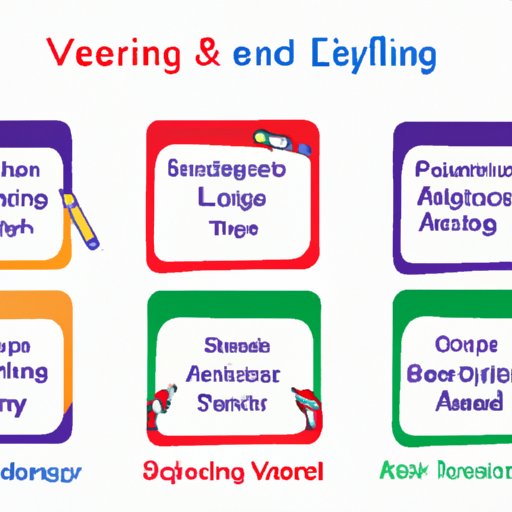
Introduction
Learning styles refer to the ways in which people process and retain information. Understanding the different learning styles is important as it allows educators and individuals to tailor their teaching methods and learning techniques to optimize the learning journey. In this article, we will explore the various learning styles, provide tips for educators to optimize their teaching, discuss how personal learning styles may influence career choices, offer an in-depth analysis of individual learning styles, and examine the latest studies on the effectiveness of different learning styles.
Providing a Comprehensive Overview of Different Learning Styles
The four most commonly recognized learning styles are visual, auditory, kinesthetic, and read/write.
Visual learners are those who learn best through visual aids, graphics, and videos. Auditory learners learn best through oral presentations, lectures, and discussions. Kinesthetic learners prefer hands-on activities and learn best through movement and action. Read/write learners excel in reading, writing, and note-taking.
Each of the four learning styles requires specific techniques and approaches to optimize learning. For example, visual learners benefit from the use of charts, diagrams, and mind maps for organization and memorization, while auditory learners benefit from taking notes during lectures and repeating information through oral recitation.
Take this quiz to determine what type of learning style best suits you:
Tips and Strategies for Educators to Optimize Their Teaching for Each Learning Style
Educators can effectively optimize their teaching by catering to all the learning styles. For visual learners, the use of visual aids and images can significantly enhance understanding. Auditory learners benefit from verbal instruction and group discussions where they can express their ideas out loud. Kinesthetic learners can be engaged through hands-on activities, while read/write learners can be accommodated through the provision of reading materials and note-taking tools.
Another valuable tip for educators is to conduct surveys at the start of the academic year to help identify each student’s learning style. This enables them to provide personalized instruction for each student.
How Personal Learning Styles May Influence Career Choices
Personal learning styles have a significant impact on career choices and job satisfaction. Individuals who excel in kinesthetic learning may find fulfillment in sports, dance, or any other career that involves physical movement. Visual learners may choose careers that require strong visual-spatial skills, such as photography and architecture. Auditory learners may excel in careers that involve verbal communication, such as public speaking or journalism, while read/write learners might prefer careers that involve analytical thinking and writing skills, such as law or research.
It is important to note that these career choices are suggestions and not set in stone. It is possible to develop skills in areas outside one’s preferred learning style and to succeed in careers that are not traditionally associated with that style.
Exploring Studies on the Effectiveness of Different Learning Styles
The debate surrounding the effectiveness of different learning styles remains ongoing. While some studies have shown that certain learning styles result in increased learning outcomes, there is no conclusive evidence that one style is superior to the others.
The most widely accepted theory is that individuals have a preferred learning style, but that this preference does not necessarily lead to better learning outcomes. Instead, it is beneficial to utilize all methods of learning to maximize individual potential.
Providing Readers with an In-Depth Analysis of Their Own Learning Style
Self-awareness is a critical component of learning, and understanding your own learning style can help optimize the learning experience. Readers can identify their own learning style through taking online quizzes, reviewing their academic history, or reflecting on their experiences in different learning environments.
Once individuals know their learning style, they can optimize their learning by developing strategies that cater to their strengths and work on improving areas where they may struggle.
Conclusion
Understanding the different learning styles is essential for optimizing learning. In this article, we explored the four most commonly recognized learning styles, provided tips and strategies for educators, discussed how personal learning styles may influence career choices, examined the effectiveness of different learning styles, and offered advice on how to conduct an in-depth analysis of one’s own learning style. We hope this article inspires individuals to take a personalized approach to their learning journey.




